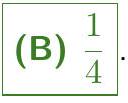Problem:
Raashan, Sylvia, and Ted play the following game. Each starts with . A bell rings every 15 seconds, at which time each of the players who currently have money simultaneously chooses one of the other two players independently and at random and gives to that player. What is the probability that after the bell has rung 2019 times, each player will have ? (For example, Raashan and Ted may each decide to give to Sylvia, and Sylvia may decide to give her dollar to Ted, at which point Raashan will have , Sylvia would have , and Ted would have , and and that is the end of the first round of play. In the second round Raashan has no money to give, but Sylvia and Ted might choose each other to give their to, and and the holdings will be the same at the end of the second round.
Answer Choices:
A.
B.
C.
D.
E. \dfrac{2}
Solution:
On the first turn, each player starts off with . Each turn after that, there are only two possibilities: either everyone stays at , which we will write as , or the distribution of money becomes in some order, which we write as . cannot be achieved since either(1)the person cannot give money to himself or there are a maximum of dollars being distributed and the person has nothing to start with). We will consider these two states separately.
In the state, each person has two choices for whom to give their dollar to, meaning there are possible ways that the money can be rearranged. Note that there are only two ways that we can reach again:
Raashan gives his money to Sylvia, who gives her money to Ted, who gives his money to Raashan.
Raashan gives his money to Ted, who gives his money to Sylvia, who gives her money to Raashan.
Thus, the probability of staying in the state is , while the probability of going to the state is (we can check that the 6 other possibilities lead to )
In the state, we will label the person with as person , the person with as person , and the person with as person C. Person A has two options for whom to give money to, and person has options for whom to give money to, meaning there are total ways the money can be redistributed. The only way that the distribution can return to is if gives to , and gives to . We check the other possibilities to find that they all lead back to . Thus, the probability of going to the state is , while the probability of staying in the state is .
No matter which state we are in, the probability of going to the state is always . This means that, after the bell rings 2018 times, regardless of what state the money distribution is in, there is a probability of going to the state after the 2019th bell ring. Thus, our answer is simply

OR
After the first ring, either nothing changes, or someone has . No one can have , since in that hypothetical round, that person would have to give away . Thus, the outcome is either or six symmetrical cases where one person gets (e.g. a or split).
Case : Probability of returning to from
There are two ways for the three people to exchange dollars to get to the same result. To see this, seat , and in a circle. Each person gives their dollar to either the person at left, or at right, to result in again 1 dollar for each person. There are 8 overall possibilities (since each person has 2 choices when giving away his or her dollar, therefore total possibilities). So, there is chance of returning to .
Case : Probability of returning to from
Without loss of generality, take the case. Only 2 people can give money, so there are now possible outcomes after the bell rings. It either decomposes back into (remained unchanged), . Thus, there is a chance of returning to . Notice that this works for any of the cases, as each is symmetrical to the others.
Answer
Since the starting state has a chance of remaining unchanged, and each of the different symmetric states all also have a chance of reverting back to , the chance of it being after any state is always
The problems on this page are the property of the MAA's American Mathematics Competitions